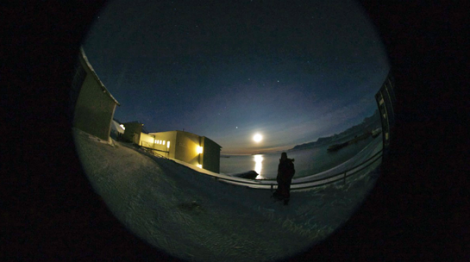
Profile: A lighter marine night
The Marine Night project delves deeper into the workings of the Arctic polar night to study biodiversity, food chains, interaction and social processes and how they are changing in the wake of climate change.
Early studies in the Arctic suggested that ice-covered areas were generally unproductive. Evidence of human settlements in the high Arctic over several thousand years, however, conflicted with these early observations and constituted a paradox as to how human populations could subsist in regions considered to be biological deserts. Further investigations revealed significant productivity under ice-covered seas and the existence of productivity hot spots, demonstrating the significance of the complex links between ice, ocean, and land in Arctic ecosystems. During the last 20 years, national and international research efforts in the Arctic have increased significantly, leading to the fourth International Polar Year (IPY, 2007-2008, see here).
Highlights of the IPY work include cataloguing marine biodiversity from bacteria to top predators, documenting the importance of sea ice cover for a variety of ecosystem processes, studying the relationships between physical, chemical, and biotic processes on small spatial scales, describing the oceanography of previously poorly known areas, and investigating atmosphere-ice-ocean feedback relationships. In addition, there have been significant developments in research infrastructure, including novel remote sensing and in situ monitoring technologies and the algorithms for interpreting their output, enhanced oceanographic mooring networks, and development of international databases and long term monitoring facilities. Nevertheless, observations of the properties and processes occurring during the winter have been sparse and to a large degree opportunistic. With some exceptions, data have generally been restricted to fixed observatories, which lack important spatial resolution, or from freely drifting autonomous platforms, which compromises the repeatability necessary to quantify interannual variability.
A classical paradigm in Arctic marine ecology holds that most biological processes at high latitudes are reduced to a minimum during the polar night due to low food availability and the reduction in light – in effect a period of winter dormancy. Recent discoveries under the extreme conditions of the Arctic winter challenge our understanding of Arctic marine organisms and ecosystem processes. For example, there is a long-held presumption that the polar night at high latitudes represents total darkness, yet new data indicate that Arctic organisms respond to light levels undetectable by the human eye. Further, recent research reporting active vertical migration of zooplankton and bioluminescence levels indicative of functional activity in several zooplankton taxa has challenged the assumption of winter dormancy. Both these phenomena had been assumed to be absent during the polar night. A recent expedition at 80° north during the darkest period of the polar night recorded five different species of seabirds actively foraging at sea: little auk (Alle alle), black-legged kittiwake (Rissa tridactyla), northern fulmar (Fulmarus glacialis), black guillemot (Cepphus grylle) and Brünnich’s guillemot (Uria lomvia). Such sightings during the dark season are sporadic, with low numbers of individuals observed, so it remains a mystery how these visual predators are able to detect their prey.
In addition, the current reduction of Arctic sea ice cover and thickness is likely to have both direct and indirect impacts on marine organisms, their interactions and ultimately ecosystem processes. However, without a more complete perception of Arctic ecosystem function, such impacts will remain largely impossible to understand and predict. Research into the polar night biology of the Arctic has the potential for radically altering our perception of the Arctic marine ecosystem, mechanisms governing ecosystem processes, and how a continued warming of the Arctic will affect ecosystem structure and function.
The primary objective of Marine Night is to achieve a basic understanding of Arctic biodiversity and food web structure during the polar night, and how ecological processes from reproduction and growth to trophic interactions and life-history processes during this nearly unstudied time contribute to the functioning of Arctic ecosystems. We will reach this primary objective by addressing three main research questions (research units 1-3) and a fourth unit:
Unit 1: How do physical and biological factors regulate the recently discovered processes occurring among marine zooplankton during the high Arctic polar night?;
Unit 2: In the absence of light and primary production, are the biodiversity patterns and community structure of benthos during the polar night different from those observed during the polar day?;
Unit 3: Climate change case studies – what are the consequences of a changing climate?; and
Unit 4: Outreach, communication and data management.

Professor Dr Philos Jørgen Berge
Project leader
Institute for Arctic and Marine Biology
UiT – The Arctic University of Norway
Norway
+47 (0)776 46036




